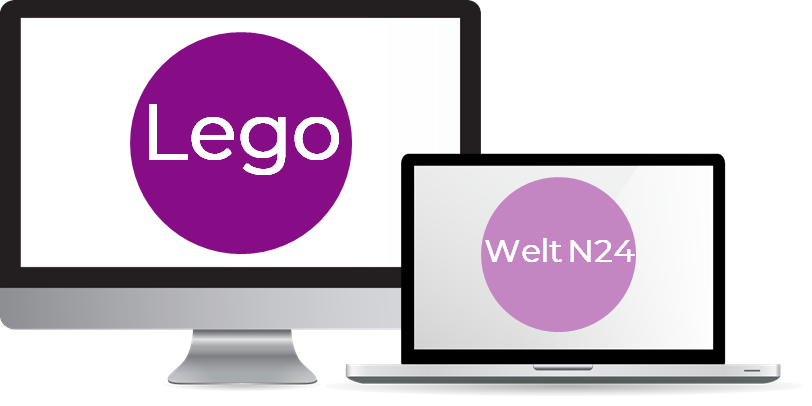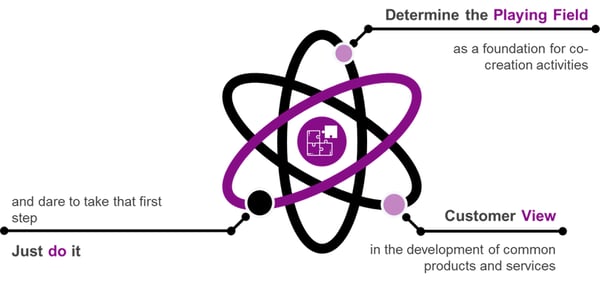
Is it possible to increase customer orientation? Our answer: Yes. The expansion stage, customer orientation 2.0 so to speak, lies in co-creation. In doing so, you find a common cause with your customers. More specifically, a business interacts with potential customers to improve or develop its products or services. The scope ranges from the design of personalized components to complete product development. The pooling of experience, knowledge, and innovation potential creates ideas from which both sides profit: The company actually answers the market demand with its products or services and can grow accordingly. The customers receive exactly the solutions they desire or need to achieve their strategic goals.
Whether it's a personalized sports shoe or a customized automobile - in the area of business-to-customer, co-creation has long been established across many industries. Using online configurators or apps, anyone interested can create an individualized product, view it at the push of a button, and buy it. Co-creation is a process that strengthens the relationship between customer and company and positively enhances product life.
The individualized product or service design enables an increase in sales and profits as well as the reduction of internal processing costs. You can generate new customers, increase satisfaction, and achieve higher margins than standard products. At the same time, there are a few unanticipated developments, as reaction times and complaint rates decline. The sometimes higher production costs are thus compensated for. By digitalizing and automating, you can additionally streamline production and logistics processes. For example, an online configurator can be integrated into the goods management system and production can be supplied by driverless transport systems. As a logistics service provider, we are happy to help you with the planning or implementation of possible measures. More information can be found under the link: Digitalization Along the Supply Chain. At the end of co-creation in the B2C sector, mass production is in "Lot Size One". The digital world manages to combine the highest possible individuality with the highest possible standardization. This makes customers true, less price-sensitive fans.
The following examples show how to successfully translate customer ideas into products or services:
Lego is the largest toy manufacturer in the world. The company integrates its customers, regardless of age, via an online community in the development of new product ideas. Members can post new ideas for play sets, exchange ideas, and rate them. Any idea that receives 10,000 votes is reviewed internally by Lego, implemented if necessary, and distributed worldwide. In addition to a personal play set, the idea generator receives a percentage of the sales proceeds and is named on the product packaging as well as in the advertising presentation. The customer is rewarded for his innovative strength, his creativity and his entrepreneurial thinking.
The second example deals with digital co-creation at Axel Springer. The company has developed the relaunch of the Internet offer of WeltN24 in collaboration with the users. The base for this was the social media platform Facebook. Facebook group users could help shape desired features, colors, image sharing, etc using a beta version. At the same time, the interfaces were subjected to a pre-test: The users discovered what was working and what was not, so that undesirable developments could be counteracted in good time. A win-win situation: The users identify with the portal. The WeltN24 has a website on the way.

Can you use co-creation in B2B as well? Absolutely! Even with complex challenges, the combination of internal expert knowledge and an external customer perspective can generate ideas and stimulate innovation processes. Your customers usually have clear ideas about what the future product should look like and how it should work. As a supplier, you have the know-how to implement it.
What sounds so simple can sometime require methodological support. If customer requirements are misinterpreted during cooperation, it could ultimately lead to dissatisfaction and expensive adjustments. This can be prevented. Personal conversation, the early involvement of the customer in the implementation (e.g. through workshops), and transparent communication minimizes dissatisfaction rates. Digital offers the following methods:
The potential of co-creation in the B2B sector has guided us at Müller - Die lila Logistik to the principle of the Lila Solution Factory. Their goal is to assemble service products according to individual customer needs while orienting them to their requirements by integrating the customers into the solution development. We are happy to start a project with you.
We want to give you three ideas for co-creation. In addition, a basic recommendation: Get rid of product thinking! Think from the perspective of the customer and in customer solutions.
The playing field forms the foundation of co-creation activities and sets the system. Define these basic conditions in a project plan that applies throughout the duration of the collaboration.
Don't immediately think about your ROI. Your customers invest valuable time in the joint development of products and services that can lead to economic success for you. Keep the customer motivated throughout the project. That means not just listening to them but understanding them.
Many wonderful innovations never materialize because the first step is never braved. Simply invite different customers at the beginning to idea competitions. The network effect and the joint, cross-sectoral exchange create new ideas that are often enough to trigger a new product or to improve existing services. By implementing the first prototypes or pilot projects, the co-creation process, which initially sounds so abstract, can be tangibly experienced.

We at Müller - Die lila Logistik are convinced that solutions for tomorrow's world will find whoever is willing to think and act across borders. This applies to the individual company and in a macroeconomic-social context. In our book, "VORDENKEN", we look into the future with experts from business, science, society, and politics. You can download a free reading sample via the link below.
If you want to find out more about co-creation in logistics and how we at LILA LOGISTIK realize potential along the supply chain with our customers, feel free to contact us.
Müller - Die lila Logistik SE
Ferdinand-Porsche-Str. 6
74354 Besigheim
Germany